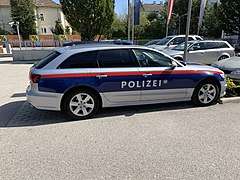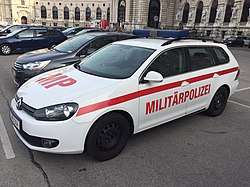Law enforcement in Austria
Law enforcement in Austria is the responsibility of the Directorate General for Public Security, a subdivision of the Federal Ministry of the Interior located at Herrengasse 7 in Vienna. Over 20,000 police officers are on duty in the Federal Police at more than 1,000 police stations. On lakes and rivers the federal police has over 70 boats and other craft to act as the Water police.

The phone number 059133 connects you to the nearest police station anywhere in Austria. The emergency number is 133.

Law enforcement agencies
Federal
Ministry of Defence
- Militärpolizei: Military Police of the Austrian Armed Forces

Ministry of Finance
- Finanzpolizei: Financial Guard
- Operative Zollaufsicht (OZA): Customs Service

Federal Ministry of the Interior
- Bundesamt zur Korruptionsprävention und Korruptionsbekämpfung (BAK): Federal Bureau to prevent and to fight corruption
- Generaldirektion für öffentliche Sicherheit (GDföS): Directorate General for Public Security
- Bundeskriminalamt (BK): Federal Investigation Bureau
- Bundespolizei: Federal Police Service, divided into 83 district police commands and 27 city police commands
- Alpinpolizei: Mountain Police in ski ressorts, part of Federal Police
- Bereitschaftseinheit Wien: Standby Police Unit for Vienna
- Einsatzeinheit: Riot Police of Federal Police
- Landesverkehrsabteilung: Traffic and highway Police
- See- und Stromdienst: River branch of Federal Police
- Sonderdienste Sektor: SWAT unit of Federal Police in Graz
- WEGA: SWAT unit of Federal Police in Vienna
- Einsatzkommando Cobra (EKO Cobra): Federal SWAT and special forces unit

- Flugpolizei: Air Police
- Sondereinheit für Observation (SEO): Special Unit for Covered Technical Surveillance
Ministry of Justice
- Justizwache (JW): Penitentiary Police
- Justizwache Einsatzgruppe (JEG): SWAT Team of Penitentiary Police
State
In general, there are no state law enforcement offices for public safety permitted, only on the federal and municipal level of administration by the Austrian Constitution, only for their sphere of authority like the states´ conservation and wildlife protection.
- Tyrol
- Tiroler Bergwacht: it enforces conservation and wildlife protection laws in the state of Tyrol.
Municipalities
- Stadtpolizei: Municipal police, in 21 municipalities
- Ordnungsamt: An arm of the municipal government tasked with enforcing municipal ordinances. In cities with their own municipal police forces, the municipal police doubles as the Ordnungsamt. As of 2018, there are Ordnungsämter in six communities. In two of these, the Ordnungsamt is conventionally called Ordnungswache; in one of them, Mobile Überwachungsgruppe. The difference in terminology has no legal significance.
- Ordnungsdienst: An Ordnungsamt that is technically a private corporation (held by the municipality) as opposed to a department of the municipal government. As of 2018, there is exactly one Ordnungsdienst in Austria, in the city of Linz.
- Straßenaufsicht: Municipal traffic enforcement
Requirements of Police Officers
Police officers in Austria must meet certain requirements. These requirements include being at least 18 years of age, Austrian citizenship, an ability to act (not burdened by physical disability), impeccable reputation, Class B driver's licence, if conscripted to the armed forces, to have completed that conscription, and a swimming badge to prove swimming ability.[1]
See also
- Anti-corruption agency
- Crime in Austria
- List of law enforcement agencies
